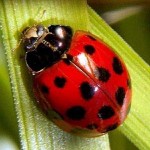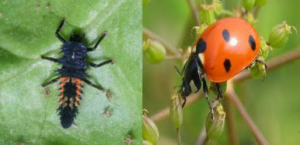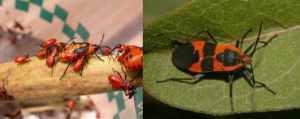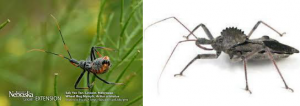READY TO GET STARTED?
REQUEST A FREE ESTIMATE
Fill out the form below or call (888) 466-7849 for a free, no-obligation estimate.
It’s summer time and BBQ season is in full effect. Naturally, your family and friends aren’t the only ones attracted to the smell of something good on the grill. We at Northwest Exterminating provide extensive treatments for mosquitos, fleas & ticks and other creepy crawlers that may want to stop by. However, being proactive in small ways can add to the benefits of pest and mosquito control. Below is a list of tips to help you keep your BBQ guests from getting bugged!
Sources:
http://www.ehow.com/how_8229328_keep-bugs-away-during-barbecue.html
 There are more than 5,000 different ladybug species in the world, known by many different names. Ladybird beetles, lady beetles, ladybirds, God’s cow, lady clock, lady cow, lady fly..these are just to name a few. The easiest way to tell a ladybug from another insect is their appearance: their bodies are always a round or oval dome-shape, they have a hard shell wing that covers their inner wings, and they are able to retract their head like a turtle.
There are more than 5,000 different ladybug species in the world, known by many different names. Ladybird beetles, lady beetles, ladybirds, God’s cow, lady clock, lady cow, lady fly..these are just to name a few. The easiest way to tell a ladybug from another insect is their appearance: their bodies are always a round or oval dome-shape, they have a hard shell wing that covers their inner wings, and they are able to retract their head like a turtle.
Ladybugs leave their summer feeding grounds in fields, forests, and yards and begin to appear indoors in the fall looking for a place to spend the winter. Children love ladybugs because they are easy to catch and they are bright in color. Gardner’s also enjoy them and consider them useful as they eat aphids or insects. Many cultures consider ladybugs lucky and in many countries the sight of a ladybug is either a call to make a wish or a sign that a wish will soon be granted. Ladybugs are the state insect of Delaware, Massachusetts, New Hampshire, New York, Ohio, and Tennessee. They are the official national mascot for the Alpha Sigma Alpha sorority in the United States and the mascot of a ski resort in Spain.
Barry Teubert
Northwest Exterminating
Savannah Service Center Manager
[email protected]
All creatures are capable of fantastic feats, some of which we are accustomed to. Birds fly, fish swim and bees buzz along as they collect nectar. We’re so used to certain animals doing certain things that we marvel when they do something unexpected. After all, wouldn’t it shock you if animals could talk like humans? That is, until you have a conversation with a parrot. Below we feature some creatures you know well and finally get an explanation for how the neat tricks they do!
Squirrels Flying
Flying squirrels aren’t as a familiar as their red or gray sisters because when you’re likely to be sleep when they tend to be out. In North America there are two species of flying squirrel – the northern flying squirrel and the southern flying squirrel. Contrary to what their name suggests, flying squirrels don’t fly because they don’t have wings. They do however, have web-like folds of skin known as patagium which when get taught when they stretch their bodies out and help them glide from high altitudes.
Snakes Swimming
Though some snakes are known specifically for being in the water, all snakes can swim. This may boggle the mind because these creatures have no arms or fins! However, they glide gracefully through the water by moving their body laterally, as if twisting into an ‘S’ shape. These movements start at the head and continue through its body, allowing them to exert a force backwards against the water, effectively moving their bodies forward. Those we typically refer to as water snakes have flatter bodies which make it more efficient for them to swim.
Bugs Walking on Water
Scientists used to believe that bugs secreted a wax on their legs that helped them take advantage of the surface tension of water. Now they believe that insect’s legs have microscopic hairs that trap air bubbles to allow them to float.
Spring is a time when everything comes to life, blooming into an array of lovely colors. You’ll see flowers that are pink and purple, baby bunnies that are tan or gray and insects that are red and black. Just like every other little life form emerging this time of year, insects can also be a variety of colors and it’s important not to get them confused. Some bugs you might spot frequently are of the Georgia Bulldog variety – red and black spots, stripes and even a combination of both.
If any of these insects or other pests become too much of nuisance, Northwest Exterminating has the expertise and knowledge to take care of your bug problems. Our Director of Pest Services Adam Vannest has provided some information about these bugs that will help you know the difference and what measures to take against them.
Lady Bug
 – Beneficial insect
– Beneficial insect
– Overwinters
– Feeds on aphids
– Control Measures: exclusion and vacuuming for long-term prevention. When necessary, chemical contact treatments can knock down a population
Box Elder Bug
– Overwinters
– Female: Box Elder trees and Silver Maple trees serve as the primary host plant
– Control Measures: Exclusion and a contact/residual application around the foundation and base of host plant
Milkweed Bug
 – Found in gardens on Milkweed plants or around shelled sunflower seeds
– Found in gardens on Milkweed plants or around shelled sunflower seeds
– Control Measures: Over-the-counter garden insecticides
Leaf-Footed Stink Bug
– Feeds on a wide variety of host plants
– Besides birds, they do not have too many natural predators due to their taste and smell
– Control Measures: Over-the-counter insecticides for garden areas. Outside of the garden, any contact or residual product labeled for stink bugs
Wheel Bug

– Semicircular cogwheel-like crest on its thorax
– Feeds on a wide variety of insects including caterpillars, beetles, aphids
Control Measures: Prevention is the key! All plants should be inspected before they enter the home. Exclusion should be performed for long-term prevention. All vegetation should be trimmed away from the home, at least one foot. Pesticides are rarely needed
Spring is a time when everything comes to life, blooming into an array of lovely colors. You’ll see flowers that are pink and purple, baby bunnies that are tan or gray and insects that are red and black. Just like every other little life form emerging this time of year, insects can also be a variety of colors and it’s important not to get them confused. Some bugs you might spot frequently are of the Georgia Bulldog variety – red and black spots, stripes and even a combination of both.
If any of these insects or other pests become too much of nuisance, Northwest Exterminating has the expertise and knowledge to take care of your bug problems. Our Director of Pest Services Adam Vannest has provided some information about these bugs that will help you know the difference and what measures to take against them.
– Overwinters
– Feeds on aphids
– Control Measures: exclusion and vacuuming for long-term prevention. When necessary, chemical contact treatments can knock down a population
Box Elder Bug
– Overwinters
– Female: Box Elder trees and Silver Maple trees serve as the primary host plant
– Control Measures: Exclusion and a contact/residual application around the foundation and base of host plant
Milkweed Bug
 – Found in gardens on Milkweed plants or around shelled sunflower seeds
– Found in gardens on Milkweed plants or around shelled sunflower seeds
– Control Measures: Over-the-counter garden insecticides
Leaf-Footed Stink Bug
– Feeds on a wide variety of host plants
– Besides birds, they do not have too many natural predators due to their taste and smell
– Control Measures: Over-the-counter insecticides for garden areas. Outside of the garden, any contact or residual product labeled for stink bugs
Wheel Bug
– Semicircular cogwheel-like crest on its thorax
– Feeds on a wide variety of insects including caterpillars, beetles, aphids
Control Measures: Prevention is the key! All plants should be inspected before they enter the home. Exclusion should be performed for long-term prevention. All vegetation should be trimmed away from the home, at least one foot. Pesticides are rarely needed